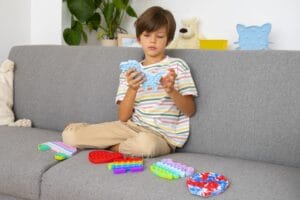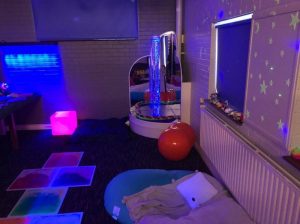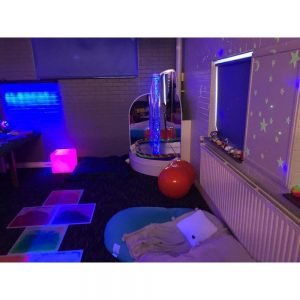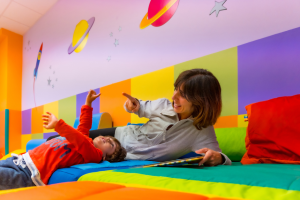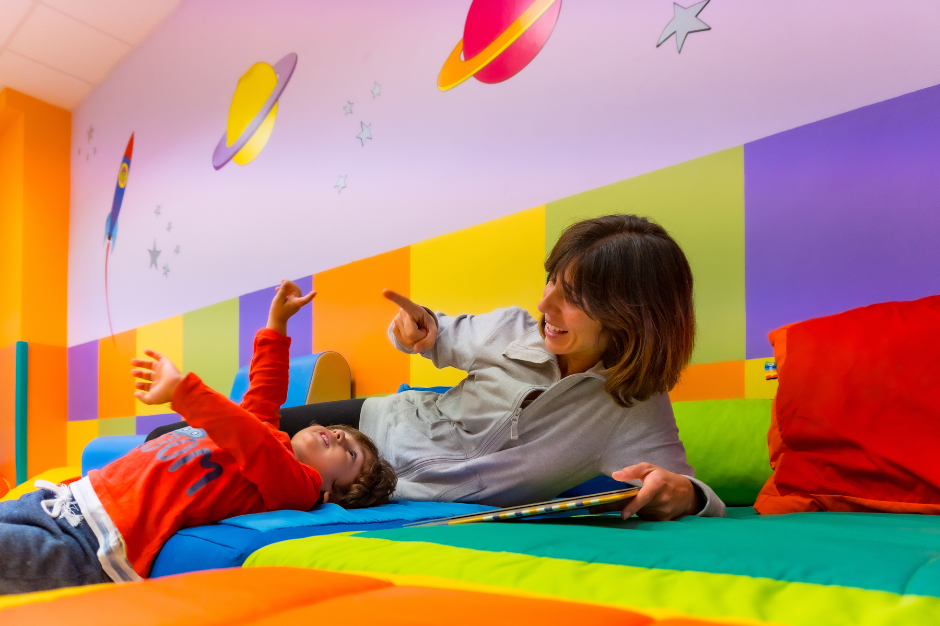Do you enjoy winding down after a long day? What does your relaxation routine look like? Maybe you get home after work, put on your favourite music, and run a bath or take a shower with your favourite scented soap. Once you’re clean, you wear soft pyjamas and find something interesting to watch or read. As you begin to settle down, you may have a snack. Is it sweet, salty, crunchy, or savoury? Possibly a combination of these tastes? Did you know that you’re engaging in sensory stimulation? Our senses are deeply connected with our emotional wellbeing. Do you wish you had a room in your home, office, or in public spaces dedicated to invigorating your senses? If you answered yes, you’re in luck; sensory stimulation environments exist for this exact purpose.
Since their development in the 1970s, sensory rooms have become popular therapy solutions in over 400 countries. These customised spaces are often utilised by individuals with Autism or Sensory Processing Disorder. Children and adults alike may benefit from the use of these spaces. Dealing with everyday tasks can be overwhelming for people with SPD, who may be overstimulated or under stimulated by different sights, sounds, and smells. So, what does sensory overload or underload look like?
Sensory Overload
- Agitated behaviour
- Easily irritated
- Difficulty concentrating
- Sensitivity to different fabrics
- Visible discomfort
- The urge to shield your ears or eyes
Sensory underload
- Easily fatigued
- Introverted behaviour
- Dissociation
- Flat affect (diminished expression of emotion)
- Fidgeting and repetitive behaviours
- Restlessness or boredom
Multimodal spaces can offer solace to those who face these sensory processing issues and can also be valuable in relaxation practices for neurotypical individuals. The goal of these unique spaces is to support sensory stimulation and self-regulation for anyone that needs it. If you’re interested in learning more about multisensory spaces, here are the top 5 benefits of creating a sensory room in school, at home, or as an addition to public spaces.
- Sensory engagement – These spaces are customised with all sensory needs in mind, by a sensory solutions expert with a combination of sensory toys and specialised equipment.
- Improved concentration – Multisensory areas are ideal therapy treatment options to promote attention and focus with different activities and interactive devices.
- Cognitive improvement – Through consistent sensory play, these spaces have supported cognitive development by activating neural pathways in individuals with ASD and SPD.
- Socialisation – Individuals who utilise these areas gain improved social skills by engaging in play and interaction with others using the space.
- Increased motor skills – Active play and physical activity are encouraged in these spaces and improve motor skill development with jumping, swinging, yoga, and running in a safe environment.
What Is a Sensory Room – How Does It Work?
Picture this. You’re in a crowded shop, it’s noisy, people are encroaching on your space; the fluorescent lights are overwhelmingly bright; and you can feel your anxiety building. All you want at this moment is a quiet place away from the assault on your senses. This reality is what is known as sensory overstimulation and is a common occurrence for children and adults with Autism or SPD. How can anyone deal with these stressors? With the use of a sensory room, someone experiencing sensory issues can begin the process of self-regulation and finding peace.
- A quiet place — These areas are calm spaces meant for self-regulation and relaxation. A quiet and calming area is designed by using a space that is far from ambient noise, has dim lighting, provides cosy seating, and has tranquil music or sound machines.
- Interaction and fun — For individuals who need to have their senses stimulated to centre themselves, sensory spaces employ interactive equipment and toys. The use of sensory walls, bubble tubes, and light projectors promotes a revitalising of the senses in a fun way.
- A multipurpose area — These areas aren’t only for sensory stimulation but are also used in schools to complete educational activities, by therapists for energizing therapy sessions, and in hospitals by medical professionals to conduct evaluations.
What are the Benefits of Sensory Rooms for Children, Adults, and Dementia Patients?
Throughout Ireland, multisensory rooms are finding their place as ideal treatment options for children, adults, and even dementia patients. There is a growing awareness of the importance of inclusive spaces for those that have Autism, SPD, or cognitive issues. Sensory rooms are a remedy to a widespread issue and a welcome addition to homes, schools, and public spaces. The ability to have a space to calm any overwhelming feelings or engage in stimulation is integral to the Autism and SPD communities.
These spaces are adaptable for any population, and that is what makes them so special. They provide a fun and interactive space for children to delight in the colours and sounds. For adults, they are serene spaces to find respite and rest away from sensory triggers. Any person of any age, cognitive ability, and motor function can engage in play. In care homes, multimodal areas have proven invigorating for elderly individuals that suffer from dementia. These spaces provide them with engagement in sensory activities, calming music, and beautiful light displays that help them cope with their condition.
If you’re interested in creating a sensory room of your own, read more about the number of ways these spaces can help anyone.
- Physical activity – Sensory areas promote physical activity with space for movement, soft padding, and equipment that inspires play and physicality.
- Mental health – Individuals that use these spaces are supported with peace and positivity and, as a result, see improvement in their mental health.
- Cognitive health – Cognitive function is increased through sensory activity, play, and therapy practises, conducted in these areas.
- Interoception – Consistent use of these rooms helps individuals improve their interoceptive functions and understand their body’s messages.
- Social skills – Socialization is promoted with learning activities, wellness approaches, and sensory toys and equipment.
- Proprioception – Sensory spaces provide room to work on proprioceptive issues and result in improved spatial awareness, balance, muscle strength, gait, and posture.
How to Design a Sensory Space for an Adult
Multisensory rooms are being embraced by the people of Ireland and are being implemented in a variety of places that are welcoming inclusivity in their environments. Public spaces such as airports, schools, and theme parks are creating customised sensory areas to help individuals cope with SPD. When researching how to design a sensory room, you’ll often find information that caters to children with ASD or SPD. However, these spaces are beneficial to people of all ages. If you need some inspiration on how you can customise your sensory environment, have a look at our design ideas.
- Be playful — Everyone deserves to play. Having fun and engaging in active play is an important activity that invigorates the body, mind, and soul. A sensory room can be outfitted with fun and colourful sensory devices such as stress balls, fidget poppers, and fidget spinners. To get the body moving, these spaces can be equipped with hammocks, balance boards, and trampolines.
- Inspire interaction – It is important to create an engaging environment, when designing a multisensory space. Interaction can be created with sensory equipment that caters to multiple senses, such as sensory mirrors and bubble tubes.
- Incorporate sound — To create an effective sensory environment, you need to incorporate soothing elements in your space. You can use serene music and sounds to provide a peaceful atmosphere. To create a combination of calmness and interaction, you can use light up speakers, sound machines, and plasma lava lamps. You can supply noise-cancelling headphones or earplugs to calm the overwhelmed by noise disturbances.
- Light up – Illuminate your sensory space with gentle light to create a combination multisensory room. You can have a sensory expert install equipment such as sensory floor tiles, stalactite ceiling tiles, and infinity wall panels to brighten your room with mood lighting that calms the senses.
- Create comfort – Everyone craves comfort and needs a safe space. To create an effective sensory environment for adults, a sensory area can be equipped with items such as body socks, weighted blankets, and bean bag chairs.
- Rousing aromas — Pleasant smells are essential in creating serene and tranquil environments. When you’re designing your sensory space, use spa settings as inspiration. A sensory environment should have scents that are relaxing such as lavender, citrus, or jasmine. If you want to play with scent in other items, you can use scented playdough, smell bottles, and scented weighted plush toys.
- Mindful habits — Mindfulness is a necessary practise for emotional wellbeing. A space that includes items to motivate others to take part in these habits is essential. Meditation, yoga, and breath work are key grounding techniques when someone is feeling overwhelmed. So, it is important to use items such as yoga mats, soft cushions, and sensory puzzles to foster mindful routines.
- Include colour – When you’re researching how to design your multimodal space, you may come across rainbow rooms catered to children. Adults can enjoy these spaces too! Colour is important in helping calm or engage the senses. You can include colour in your space in various ways. Consider installing equipment such as interactive sensory wall panels, colour, UV floor mats, and sensory light projectors.
How to Create Sensory Spaces on a Budget and for Anyone
These areas provide sensory stimulation, which is essential for all individuals. Every day, humans are subjected to sensory stimuli, whether we are conscious of it or not. The foods you like, the shows you watch, and the music you listen to are all employed to stimulate your senses. This is why sensory spaces are so important, and why everyone can benefit from them.
If you’re in the process of designing a sensory space for your home, school, or public space, it can be an overwhelming experience with all the different information, specialised equipment, and various design plans. The amazing thing about sensory stimulation environments is how customisable they are! These spaces can meet any budget or need. If you’re worried about the cost of certain equipment, it is best to enlist the assistance of a reputable sensory solutions enterprise. They can walk you through the right equipment for your needs and offer you sensory packages. A sensory solutions specialist can also advise you on what you may need to start your process and help with the installation of your final design plan.
If you’re on a strict budget, don’t worry. You can purchase accessible items to meet the sensory needs of your space. Purchasing accessible but effective sensory toys or items can give you more room in your budget for specialised sensory equipment. A sensory room specialist may recommend products such as yoga mats, weighted blankets, and lava lamps to free up finances for more expensive goods that are necessary for your environment. The most crucial thing is that your environment fulfils every sensory need to be inclusive for everyone.
If you’re interested in installing this area in your home, it can be personalised to become a space that anyone will enjoy. It is important that you create a space that will work for both calming and interactive activities so that it may benefit everyone who uses it. Total Sensory Solutions specialists can bring your design dreams to fruition with a sensory room that provides for every sensory need.
We are a leading sensory solutions provider with over 25 years of industry experience. As major suppliers of sensory toys and equipment in Ireland, we strive to create and construct facilities that meet everyone’s sensory needs.
If you need more information about the benefits of a multisensory space in your home, school, or establishment — call us on 01 8414933 or send us a message.

